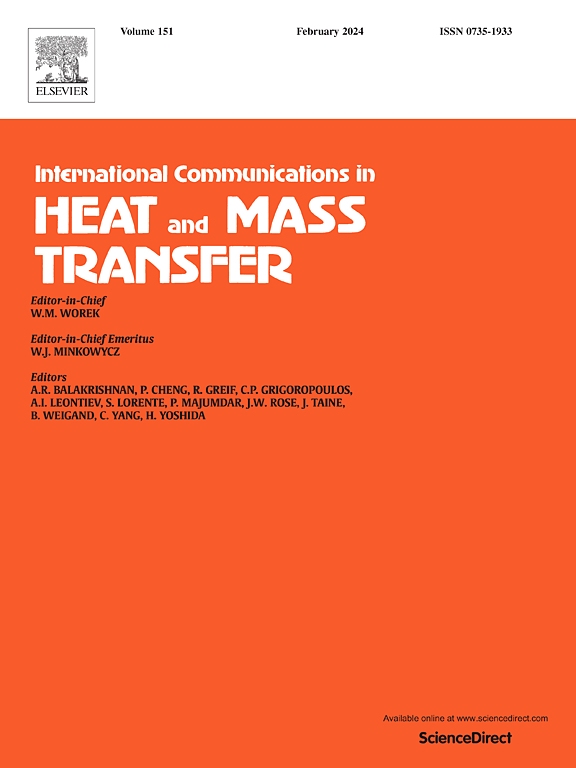Blood flow study in stenotic arteries through porous medium with heat generation
IF 6.4
2区 工程技术
Q1 MECHANICS
International Communications in Heat and Mass Transfer
Pub Date : 2025-03-28
DOI:10.1016/j.icheatmasstransfer.2025.108894
引用次数: 0
Abstract
Due to its significance in biological medicine, the passage of blood through stenotic arteries is one of the primary fields of study in mathematical fluid dynamics. The purpose of this research is to determine how human circulation influences a stenosed blood vessel. In the current study, micropolar fluid is assumed to represent human blood. Our goal in the present research is to analyze heat generation and chemical reaction in micropolar fluid flowing via a stenosed artery inserted in a porous material. To simulate the temperature and concentration distributions caused by blood flow with artery stenosis computationally with the assistance of MATLAB, the constitutive equations and boundaries are simplified to non-dimensional notation by utilizing similarity transformations. For reducing the complexity of partial differential equations (PDEs), the long wavelength (LWL) and low-Reynolds numeral (LRN) approaches are employed. The Crank-Nicolson approach has been employed for evaluating the boundary conditions and governing equations for fluid flow. An appropriate geometry has been considered in order to figure out the consequence of the stenosis pattern. There includes a visual discussion of the impact of several physical parameters on the axial velocity graph, heat and mass field, including coupling number , chemical reaction , micropolar , Schmidt , Prandtl and heat generation parameter . The present study validates the choice of machine learning approach as a promising solution to model micropolar fluid flow and future work in this area.
狭窄动脉在多孔介质中产生热量的血流研究
由于其在生物医学中的重要意义,血液在狭窄动脉中的通道是数学流体动力学的主要研究领域之一。这项研究的目的是确定人体循环如何影响狭窄的血管。在目前的研究中,假定微极流体代表人体血液。我们本研究的目的是分析微极流体流经插入多孔材料的狭窄动脉时的产热和化学反应。为了借助MATLAB计算模拟动脉狭窄血流引起的温度和浓度分布,利用相似变换将本构方程和边界简化为无量纲符号。为了降低偏微分方程的复杂性,采用了长波(LWL)和低雷诺数(LRN)方法。Crank-Nicolson方法已被用于计算流体流动的边界条件和控制方程。为了计算出狭窄模式的后果,考虑了适当的几何形状。文中还可视化地讨论了几个物理参数对轴向速度图、热量和质量场的影响,包括耦合数N、化学反应ξ、微极性m、Schmidt Sc、Prandtl Pr和产热参数q。本研究验证了机器学习方法的选择是模拟微极性流体流动和该领域未来工作的一个有希望的解决方案。
本文章由计算机程序翻译,如有差异,请以英文原文为准。
求助全文
约1分钟内获得全文
求助全文
来源期刊
CiteScore
11.00
自引率
10.00%
发文量
648
审稿时长
32 days
期刊介绍:
International Communications in Heat and Mass Transfer serves as a world forum for the rapid dissemination of new ideas, new measurement techniques, preliminary findings of ongoing investigations, discussions, and criticisms in the field of heat and mass transfer. Two types of manuscript will be considered for publication: communications (short reports of new work or discussions of work which has already been published) and summaries (abstracts of reports, theses or manuscripts which are too long for publication in full). Together with its companion publication, International Journal of Heat and Mass Transfer, with which it shares the same Board of Editors, this journal is read by research workers and engineers throughout the world.

 求助内容:
求助内容: 应助结果提醒方式:
应助结果提醒方式:


